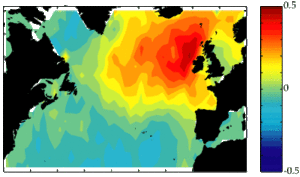North Atlantic Oscillation makes waves
Image of the month - May 2001

In winter, two air masses influence atmospheric circulation over the North Atlantic: a depression to the north around Iceland, and an anticyclone to the south around the Azores. Their intensity shapes weather conditions on the shores of the ocean.
Pressure variations in these air masses, and the associated ocean variations that interact with them, are what drive the North Atlantic Oscillation (NAO). There are two extreme or "phases" of the NAO: a positive phase, when the Azores high is especially high and the Icelandic low is lower than normal, and a negative phase, when both are weaker.
Analysis of data over several years has shown that wave heights in winter are very sensitive to pressure variations over the North Atlantic. These wave heights, measured by satellite altimetry, can thus also serve as an indicator for NAO phases and be used in climate prediction models.




